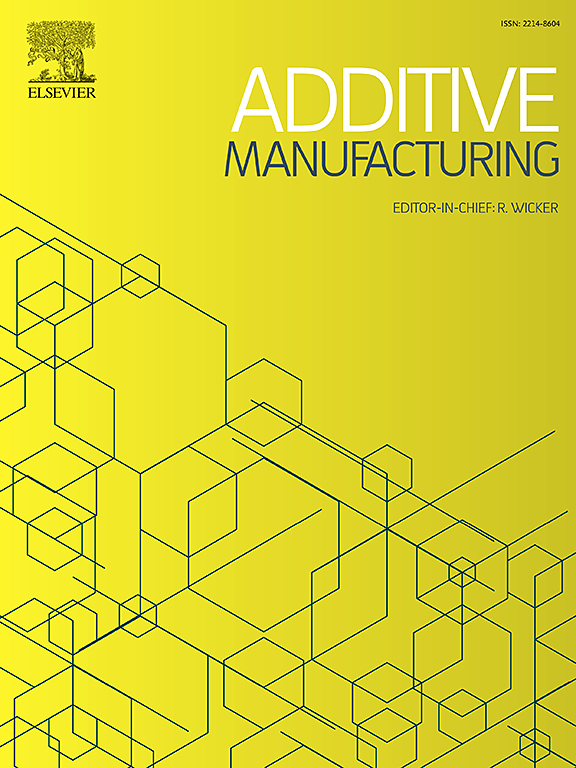Achieving uniformly refined grain structure in fusion-based metal additive manufacturing: Experimental demonstration and analytical model development
IF 10.3
1区 工程技术
Q1 ENGINEERING, MANUFACTURING
引用次数: 0
Abstract
Adding nucleants is a common method for achieving columnar to equiaxed transition (CET) in laser metal additive manufacturing (AM). However, the resulting microstructure often exhibits heterogeneity due to variations in solidification conditions across different melt pool locations, which introduces uncertainties in mechanical properties. Here, we achieved uniformly refined equiaxed grain structure at every location of the melt pool during laser powder bed fusion (LPBF) of Al6061 by adding TiC naoparticles. To elucidate the underlying mechanisms of columnar to equiaxed transition at different melt pool locations, we employed experimentally validated thermo-fluid dynamics simulations to capture the dynamic evolution of solidification conditions. Analysis using Hunt’s CET model revealed that TiC-induced heterogeneous nucleation can facilitate columnar to equiaxed transition only at the melt pool center. Further grain refinement at the melt pool boundary, characterized by a low solidification rate and a high temperature gradient, was achieved through particle-induced grain growth restriction. Given previous analytical CET models do not explicitly account for particle-induced growth restriction effects, we developed an analytical model that integrates the particle induced growth restriction mechanism for predicting grain structure. The developed model accurately predicts the grain morphology evolution at different melt pool locations observed in our Al6061+TiC samples. Our research provides quantitative insights and material design guidelines for achieving uniformly refined grain structures in fusion-based metal AM processes.
在熔融金属增材制造中实现均匀细化的晶粒结构:实验论证和分析模型开发
在激光金属增材制造(AM)中,加入核剂是实现柱状到等轴转变(CET)的常用方法。然而,由于不同熔池位置的凝固条件的变化,所得到的微观结构往往表现出不均匀性,这引入了机械性能的不确定性。在Al6061激光粉末床熔合过程中,通过添加TiC纳米颗粒,在熔池的每个位置都实现了均匀细化的等轴晶粒结构。为了阐明不同熔池位置柱状向等轴转变的潜在机制,我们采用实验验证的热流体动力学模拟来捕捉凝固条件的动态演变。利用Hunt’s CET模型分析表明,tic诱导的非均相形核只在熔池中心促进柱状向等轴转变。通过颗粒诱导的晶粒生长限制,在熔池边界进一步细化,其特点是低凝固速率和高温度梯度。鉴于以往的解析CET模型没有明确考虑颗粒诱导的生长限制效应,我们开发了一个整合颗粒诱导生长限制机制的分析模型来预测晶粒结构。所建立的模型准确地预测了Al6061+TiC样品在不同熔池位置的晶粒形态演变。我们的研究为在基于熔合的金属增材制造工艺中实现均匀精细的晶粒结构提供了定量见解和材料设计指南。
本文章由计算机程序翻译,如有差异,请以英文原文为准。
求助全文
约1分钟内获得全文
求助全文
来源期刊

Additive manufacturing
Materials Science-General Materials Science
CiteScore
19.80
自引率
12.70%
发文量
648
审稿时长
35 days
期刊介绍:
Additive Manufacturing stands as a peer-reviewed journal dedicated to delivering high-quality research papers and reviews in the field of additive manufacturing, serving both academia and industry leaders. The journal's objective is to recognize the innovative essence of additive manufacturing and its diverse applications, providing a comprehensive overview of current developments and future prospects.
The transformative potential of additive manufacturing technologies in product design and manufacturing is poised to disrupt traditional approaches. In response to this paradigm shift, a distinctive and comprehensive publication outlet was essential. Additive Manufacturing fulfills this need, offering a platform for engineers, materials scientists, and practitioners across academia and various industries to document and share innovations in these evolving technologies.
 求助内容:
求助内容: 应助结果提醒方式:
应助结果提醒方式:


